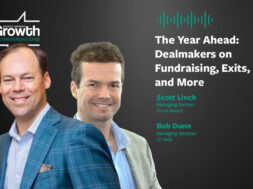InterGrowth Shatters Attendance Records
ACG’s annual conference returned in full force in April, with industry-focused content and more networking opportunities than ever

ACG InterGrowth attracted a record 2,800 registrants to the annual dealmaking event, hosted this year at the ARIA Resort & Casino in Las Vegas on April 25-27.
Attendees used the ACG Access scheduling software to set up appointments with each other during the event, and they likely found that meeting space was easy to locate. The expanded floor plan this year included additional tables, making it possible to pull up a chair for an impromptu or prescheduled meeting.
This section of the report originally appeared in Middle Market DealMaker’s Summer 2022 issue. Read the full story in the archive.
Nearly 180 investment banks were represented at the conference, and many claimed a dedicated space in the InterGrowth Lounge to use throughout the three-day event.
Networking extended beyond just the lounge. A golf tournament, daily jogging meetup and evening receptions were among the other venues where attendees could meet each other or reconnect.
The conference also included plenty of programmed content. Pamela Meyer, the bestselling author of “Liespotting: Proven Techniques to Detect Deception” who released a popular TED Talk on the topic, gave a keynote address about strategies for uncovering deception and improving negotiating skills. Brian Krolicki, chairman of the board at Faraday Future Intelligent Electric and former lieutenant governor and state treasurer of Nevada, also gave a keynote talk.
Throughout InterGrowth, attendees heard from experts during a series of featured sessions, which covered topics ranging from the evolution of business development to the impact of diversity, equity and inclusion on middle-market investments. New this year were industry-focused pavilions in the lounge, where speakers addressed trends in manufacturing, healthcare, business services, consumer goods and technology.
Below are highlights from two of the many sessions.
Throughout InterGrowth, attendees heard from experts during a series of featured sessions, which covered topics ranging from the evolution of business development to the impact of diversity, equity and inclusion on middle-market investments.
The Business Case for DE&I
Speaking on the panel “DE&I’s Impact on the Middle Market: What’s Working and How,” experts presented the business case for investing in diversity, equity and inclusion efforts. Alex Drost, founder and CEO of Connection Builders, moderated the discussion.
Panelist David Baboolall, associate partner at McKinsey & Co., pointed to a May 2020 McKinsey & Co. report whose findings revealed that even companies that invest in hiring at least one woman or person of color display performance improvements. But success is dramatically improved among companies with the most diverse boards.
What’s more, companies that fail to make meaningful investments and progress in DE&I were found to underperform significantly. Indeed, McKinsey’s research found that the least diverse organizations underperformed against their peers by 19%, up from 15% in 2017.
Baboolall, who uses the pronoun they, pointed to how diversity can yield improvements in a company’s product and service offerings, marketing and other efforts, and thus create opportunity for revenue growth.
“If you have a room full of very qualified straight, white, cis men, they will likely appeal to straight, white, cis men,” they said. “But if you decide, ‘Hey, we’re going to have a Black woman, we’re going to have queers, a biracial person, we’re going to have Asian, Latinx [staff],’ the number of people that you’re going to be able to serve with the proper product-market fit increases by so much.”
Related content: The Business Case for DE&I
In order to develop and execute on a DE&I strategy, setting the right goals is vital, panelists agreed. “Ultimately, it’s intentionality,” said Tanya Wong, vice president at Houlihan Lokey. “We need to be thoughtful, first and foremost. We need to be unafraid of the data.”
Having leadership buy-in is equally critical to the success of DE&I initiatives. “With us, it starts from the top,” said panelist Tanisha Wicker, senior vice president of human resources at Smile Brands. “Our CEO is committed. He and I work alongside one another to make sure our executive leadership team is equally committed.
“You have to have a commitment, and you have to have the right team around you,” she continued, “and you have to develop a strategy that works for your organization.”
Macro Trends Shaping Healthcare M&A
Changes to where patients receive care and how those services are paid for are among the themes shaping M&A opportunities in healthcare, according to experts from FORVIS (formerly DHG) and Marwood Group who spoke during the “Healthcare M&A Trends” session, sponsored by FORVIS, at the Healthcare Pavilion.
Related content: DHG & BKD Agree to Join Forces: What It Means for PE
During the session, Jay Stine, partner at professional services firm FORVIS, and Jennifer Meyers, managing director at Marwood, a healthcare-focused consulting firm, outlined six macro trends shaping healthcare deals today.
Those trends include growing demand for home healthcare services; a shift toward value-based care; a move away from acute-care settings; adoption of Medicare Advantage Plans; an increase in telehealth services; and continued outsourcing of revenue cycle management, staffing and other services.
On the topic of home healthcare, the speakers noted that this subsector comes with both pros and cons for investors. It often involves government payers and, in turn, regulation. At the same time, Medicare tends to provide the fastest reimbursement. “Healthcare in the home is usually highly regulated but with a payer who’s pretty quick,” Stine said.
Changes to where patients receive care and how those services are paid for are among the themes shaping M&A opportunities in healthcare.
Investors looking to capitalize on this trend aren’t limited to acquiring healthcare providers. Tech-enabled solutions, for example, are an alternate means to get in on the home healthcare boom.
Another area of interest for investors is in facilities where procedures like infusions and imaging are performed outside of an acute-care setting. “Commercial payers are pushing the lower-cost setting particularly for imaging,” said Meyers.
From an M&A perspective, buyers are willing to pay more for a physician practice that also owns an ambulatory surgery center (ASC), which provides same-day procedures without requiring an overnight stay. “Expect to pay more if it’s a physician practice and an ASC,” Stine said.
Stine and Meyers pointed to out-sourcing as another trend and noted that buyers should expect to pay top dollar for highly tailored solutions— revenue cycle management software for ambulances, for example—that are selling for a premium due to their appeal.
“In the middle market, it becomes very specialized. You have to understand the specific revenue cycle process within each healthcare subindustry,” Stine said.
Meyers added that benefits management is another outsourced service where she expects to see continued growth.


